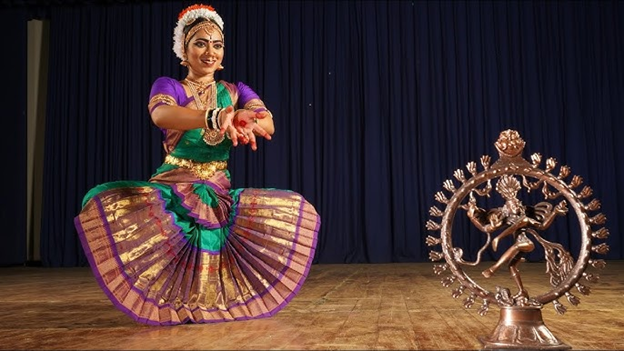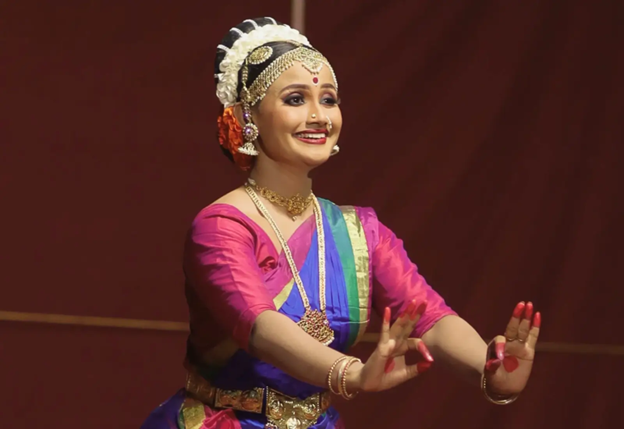Kuchipudi is a classical dance form that blends grace, rhythm, and storytelling with a deep-rooted connection to tradition. A well-executed performance requires not just technical skill but also dedication, rigorous practice, and an emotional connection to the composition. Preparing for a Kuchipudi composition performance involves mastering intricate choreography, perfecting expressions, and ensuring physical endurance. In this blog, Nrityangana explores the structured process that dancers follow to bring their performance to life.
Understanding the Composition and Its Meaning
Every Kuchipudi composition tells a story, often derived from Hindu mythology, epics, or philosophical themes. Before stepping into the choreography, dancers must deeply understand the lyrics, context, and underlying emotions of the composition.
- Studying the poetry and meaning behind the composition enhances expression.
- Understanding rasa (emotion) and bhava (expression) ensures a convincing portrayal.
- Researching past performances provides insight into different interpretations of the piece.
Practicing the Core Movements and Postures
Kuchipudi postures and movements are distinct for their graceful yet energetic quality. A dancer must work on body alignment, balance, and precision before refining the performance.
- Strengthening the Araimandi (half-sitting posture) to maintain balance and stability.
- Practicing Charis (leg movements) and Kuttu Adavus (rhythmic foot tapping) to achieve sharp, defined footwork.
- Refining hand gestures (Mudras) to accurately communicate the narrative.
Developing Expressions and Facial Abhinaya

Expression, or Abhinaya, is central to a Kuchipudi performance. Unlike other dance forms that focus on rigid postures, Kuchipudi storytelling depends heavily on facial expressions and eye movements.
- Dancers practice Navarasa (the nine emotions) to effectively convey mood shifts.
- Drishti Bhedas (eye movements) are perfected to match the narrative.
- Expressions are rehearsed in front of a mirror or recorded to ensure clarity.
Synchronizing with Music and Rhythm
Kuchipudi is deeply tied to Carnatic music, requiring dancers to internalize the rhythm, beats, and melody before performing.
- Listening to the composition repeatedly to memorize rhythm patterns.
- Practicing with live or recorded music to ensure synchronization.
- Learning the importance of pauses, tempo changes, and musical cues.
Strength and Stamina Training

A Kuchipudi performance demands physical endurance due to its vigorous footwork, jumps, and rapid movements. Dancers incorporate fitness routines to build strength and avoid injuries.
- Regular practice of Yoga and core exercises to maintain flexibility.
- Endurance training to sustain energy throughout the performance.
- Cooling down exercises post-rehearsals to prevent muscle fatigue.
Costume and Ornament Preparation
The aesthetic appeal of a Kuchipudi performance is enhanced by traditional costumes and intricate jewelry. Before the stage performance, dancers prepare their attire meticulously.
- Choosing vibrant silk costumes with pleats that accentuate movements.
- Adorning temple jewelry, headpieces, and bangles to complement the character.
- Applying makeup with defined eyes and facial highlights for stage visibility.
Mental Preparation and Stage Confidence
Performing on stage requires mental focus, confidence, and emotional depth. Dancers engage in meditation and visualization techniques to overcome stage fear and enhance their presence.
- Breathing exercises to maintain calmness before the performance.
- Visualization of the dance sequence to reinforce muscle memory.
- Rehearsing stage positioning and spacing to ensure smooth transitions.
Conclusion: The Journey to a Flawless Kuchipudi Performance
A successful Kuchipudi performance is the result of dedication, rigorous training, and emotional expression. From understanding the composition’s meaning to refining postures, expressions, and synchronization with music, each step is essential. At Nrityangana, we celebrate the art of Kuchipudi and the passionate dancers who bring its rich tradition to life.


